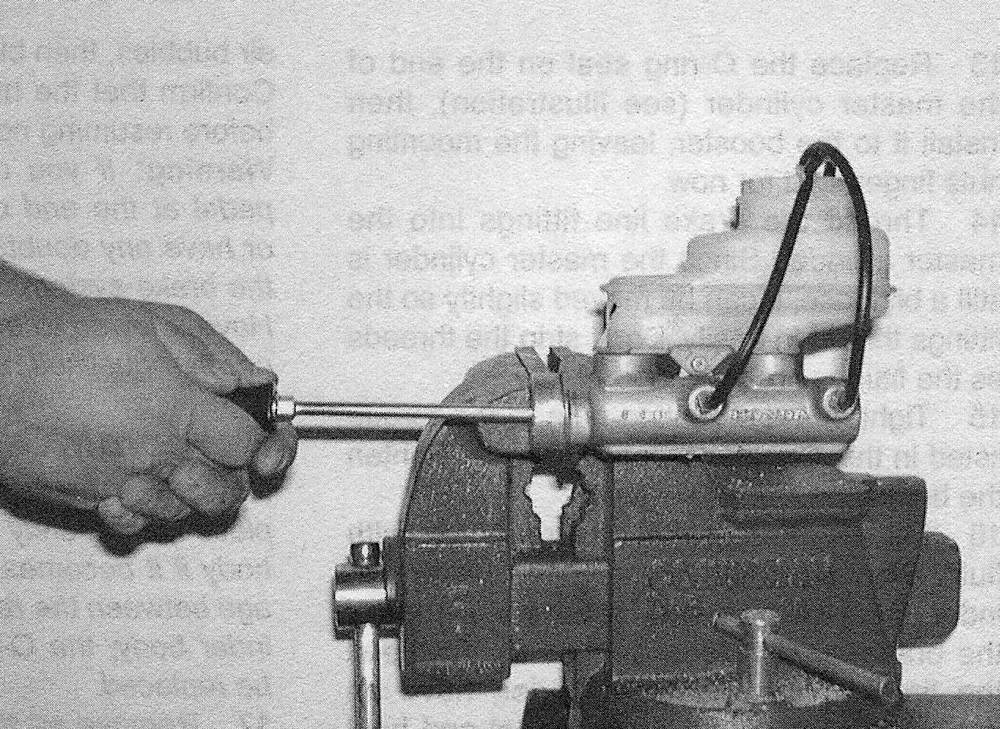Master cylinder — removal, installation and reservoir / O-ring replacement
1. Disconnect the cable from the negative battery terminal (see Engine electrical systems).
2. Unplug the electrical connector for the fluid level warning switch (see illustration).
7.2 Master cylinder mounting details:
1 Fluid level sensor electrical connector
2 Brake line fittings
3 Mounting nuts (two nuts, one on either side)

3. Remove as much fluid as possible from the reservoir with a suction gun, large syringe or a kitchen poultry baster used for brake fluid only.
Warning: If a poultry baster is used, never again use it for the preparation of food.
4. Place rags under the line fittings and prepare caps or plastic bags to cover the ends of the lines once they’re disconnected. Loosen the fittings at the ends of the brake lines where they enter the master cylinder. Use a flare-nut wrench to prevent rounding off the brake line retaining nuts.
5. Pull the brake lines away from the master cylinder and plug the ends to prevent contamination.
6. Remove the nuts attaching the master cylinder to the power booster. Pull the master cylinder off the studs to remove it. Again, be careful not to spill fluid as this is done.
Installation
7. Bench bleed the new master cylinder before installing it. Mount the master cylinder in a vise, with the jaws of the vise clamping on the mounting flange.
8. Attach a pair of master cylinder bleeder tubes to the outlet ports of the master cylinder (see illustration).
7.8 The best way to bleed air from the master cylinder before installing it on the vehicle is with a pair of bleeder tubes that direct brake fluid into the reservoir during bleeding

9. Fill the reservoir with brake fluid of the recommended type (see Tune-up and routine maintenance).
10. With the brake tubes submerged in the master cylinder, slowly push the pistons into the master cylinder (a large Phillips screwdriver can be used for this) — air will be expelled from the pressure chambers and into the reservoir. If necessary, hold the tubes from coming out of the fluid to avoid air being sucked back into the lines.
11. Repeat the procedure until no more air bubbles are present.
12. Remove the bleed tubes, one at a time, and install plugs in the open ports to prevent fluid leakage and air from entering. Install the reservoir cap. envoi is detached from the master cylinder.
13. Replace the 0-ring seal on the end of the master cylinder (see illustration), then install it to the booster, leaving the mounting nuts finger tight for now.
7.13 Install a new 0-ring on the master cylinder

14. Thread the brake line fittings into the master cylinder. Since the master cylinder is still a bit loose, it can be moved slightly so the fittings thread in easily. Don’t strip the threads as the fittings are tightened.
15. Tighten the mounting nuts to the torque listed in this Chapter’s Specifications. Tighten the brake line fittings securely.
16. Fill the master cylinder reservoir with fluid, then bleed the lines at the master cylinder, followed by bleeding the remainder of the brake system (see Brake hydraulic system — bleeding). To bleed the lines at the master cylinder, have an assistant depress the brake pedal and hold it down. Loosen the fitting to allow air and fluid to escape (see illustration). Tighten the fitting, then allow your assistant to return the pedal to its rest position. Repeat this procedure on both fittings until the fluid is free of air bubbles, then bleed the rest of the system. Confirm that the brakes are fully operational before resuming normal driving.
7.16 Have an assistant depress the brake pedal and hold it down, then loosen the fitting nut, allowing air and fluid to
escape; repeat this procedure on both fittings until the fluid is clear of air bubbles

Warning: If you do not have a firm brake pedal at the end of the bleeding procedure, or have any doubts as to the effectiveness of the brake system, DO NOT drive the vehicle. Has it towed to a dealer service department or other qualified repair shop for diagnosis?
Reservoir/O-ring replacement
Note: The brake fluid reservoir can be replaced separately from the master cylinder body if it becomes damaged. If there is leakage between the reservoir and the master cylinder body, the 0-rings on the reservoir can be replaced.
17. Remove as much fluid as possible from the reservoir with a suction gun, a large syringe, or a kitchen poultry baster that is used only for brake fluid.
18. Place rags under the master cylinder to absorb any fluid that may spill out once the res-
19. On 2500 and 3500 models, unscrew the bolts that retain the reservoir to the master cylinder. On 1500 models, carefully pry the retaining tabs outward while pulling the reservoir up to release it.
20. Pull the reservoir out of the master cylinder body.
21. If you are simply replacing the 0-rings, carefully remove the old 0-rings and install new ones.
22. Lubricate the reservoir 0-rings with clean brake fluid, then press the reservoir into place on the master cylinder body and secure it. Use new roll pins if applicable.
23. Refill the reservoir with the recommended brake fluid (see Tune-up and routine maintenance) and check for leaks.